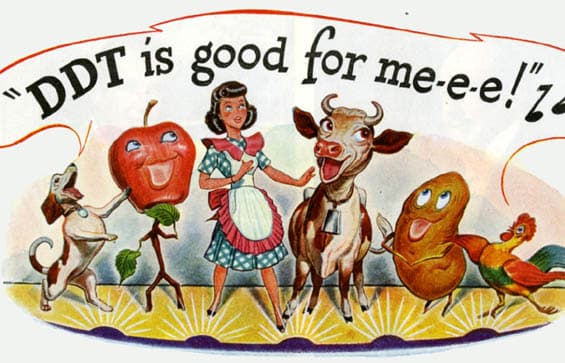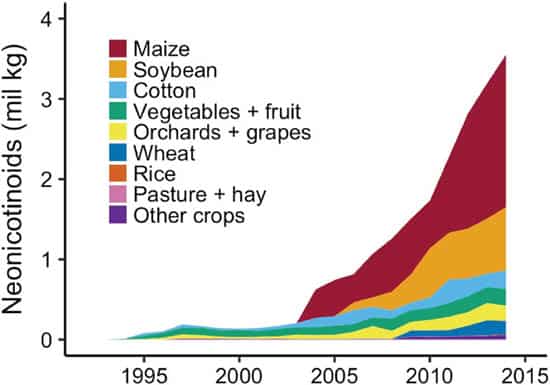This is part 3, originally published at Climate & Capitalism, of a four-part series on insect apocalypse in the Anthropocene. You can find part 1, on the sharp decline in insect populations around the world, here, and part 2, on the role of monocrop farming in destroying insect habitats, here.
| Between December 2018 and February 2019, more than five hundred million honeybees were found dead by beekeepers in southern Brazil. If wild bees had been counted, the death toll would likely have been many times higher. The main cause, laboratory analysis showed, was exposure to synthetic pesticides.1 |
The first mass produced synthetic pesticide, dichlorodiphenyltrichloroethane, better known as DDT, began commercial life as a weapon of war, a magical invention that protected U.S. troops in Asia and Africa from malaria, typhus and other diseases. Time magazine, a relentless propagandist for the American war-effort, called it “one of the great scientific discoveries of World War II.”2 It was cheap and easy to make, and, as Rachel Carson wrote in Silent Spring, it and other synthetic insecticides were vastly more deadly than any previous product.
They have immense power not merely to poison but to enter into the most vital processes of the body and change them in sinister and often deadly ways. Thus, as we shall see, they destroy the very enzymes whose function is to protect the body from harm, they block the oxidation processes from which the body receives its energy, they prevent the normal functioning of various organs, and they may initiate in certain cells the slow and irreversible change that leads to malignancy.3
Released for civilian use in 1945, DDT was inseparably linked to the rise of large scale monocrop agriculture. A farmer who planted just one type of plant was creating an attractive buffet for the few species that ate that crop, while denying homes and cover for their predators. DDT strengthened monocrops by killing the insects that the monocrops attracted. Advertisements such as this told farmers and consumers it was “a benefactor to all humanity.”

Advertisement published in Time Magazine, June 30, 1947.
But experience quickly proved that it was not an unalloyed good.
As Carson wrote, “insecticides are not selective poisons: they do not single out the one species of which we desire to be rid.”4 Birds that ate DDT-sprayed bugs died, as did fish in streams near fields that had been sprayed. Beekeepers lost hundreds of healthy hives when nearby orchards were sprayed. The poison flowed through food chains: birds that ate the small animals that ate DDT-exposed insects laid thin-shelled eggs that broke before their young could develop. Farmworkers were dying from pesticide poisoning, and by the late 1950s there was evidence that DDT and other widely-used pesticides were carcinogenic.
Like climate scientists in our time, Carson faced a vicious industry campaign to discredit her personally and ecological science in general, but ultimately — sadly, after her death — DDT was banned for most uses in North America and Europe in the 1970s. Nine organochlorine pesticides, including DDT, were banned globally by an international treaty that took effect in 2004.
But regulations and treaties have lagged far behind agrochemical reality. Chemical corporations spent fortunes to replace DDT with other killers. Pesticide production and use is now vastly greater than in Carson’s time, and the most-used products are more deadly than she could have imagined. Capitalist agriculture’s decades-long chemical war against insects has become a major driver of insect decline and extinction, and an immense agro-chemical industry has profited from the killing. As Canadian environmentalist Nick Gottlieb wrote recently, the environmental movement learned the wrong lesson from Silent Spring.
The movement seized on the idea that public awareness was all that was missing, but it failed to understand the more radical part of her analysis: that the devastation was being wrought primarily to create markets for an over productive chemical industry, not because of some kind of innate, consumer-driven demand for poison….
Carson gave us a vivid and compelling description of the barren world that the agrochemical industry was creating. But hidden within that was a clear analysis of why it was happening: the inherent drive to accumulation within capitalism and the willingness of corporations and capitalists to use every tool available to them, including the state itself, to create markets and grow profit.5
One of Carson’s most prescient warnings was that farmers would be forced to use ever-larger amounts of pesticides, because the target organisms would develop immunity — “chemical control is self-perpetuating, needing frequent and costly repetition.”6 Decades later, the insecticide treadmill is moving faster than ever, as British entomologist Dave Goulson shows.
According to official government statistics, UK farmers treated 45 million hectares of arable land with pesticides in 1990. By 2016, this had risen to 73 million hectares. The actual area of crops remained exactly the same, at 4.5 million hectares. Thus each field was, on average, treated with pesticides ten times in 1990, rising to 16.4 times in 20I6, a rise of nearly 70 per cent in just twenty-six years.7
When Carson wrote Silent Spring, the pesticide industry was producing enough poison to apply half a pound to every acre of cropland in the world. Today, it produces three times that much. As Nick Gottlieb puts it, pesticide resistance isn’t a problem for chemical manufacturers, it’s a business plan.8
That business plan involves not only selling more chemical killers, but inventing and selling more deadly products. The decline of insect life in the 21st century has been accelerated not just by the application of bigger doses of poison, but by the promotion of a new generation of superkillers.
Farmers have long known that a natural insecticide can be made by soaking tobacco in water and adding a little detergent to make it sticky. Sprayed on fruit and vegetables, the nicotine solution is a contact poison that kills aphids and other sucking insects. In 1992, Bayer introduced a related chemical — neonicotinoid means new nicotine-like — and within three years it had captured 85% of the global insecticide market. By 2016, sales by Bayer and half a dozen other manufacturers exceeded three billion U.S. dollars a year, making it by far the most widely-used and most profitable insecticide in the world.

Ubiquitous poison. U.S. Neonicotinoid use by crop, 1992 to 2014. (Source: Agricultural & Environmental Letters, October 2017. CC BY-NC-ND 4.0)
Neonicotinoids (neonics for short) offer three substantial benefits to farmers. They are less harmful to humans than previous insecticides. They are easy to use — the most common form is a seed-coating, so just planting the crop provides protection. And they are extremely good at killing insects: one tiny dose can kill 7,000 times as many honeybees as the same amount of DDT.9 A 2019 study of U.S. agricultural land found that “the toxicity loading of insecticides on agricultural land and surrounding areas has increased by approximately 50-fold over the last two decades.”10
Unlike nicotine and many other insecticides, neonics don’t just sit on plants’ surfaces — they spread through the plants’ circulatory systems, making everything from the root tips to the topmost leaves toxic. Only about five percent of the chemical actually enters the target plants, and neonics are water-soluble, so they are carried by groundwater to other plants and into streams. Since the seeds for major crops in over 100 countries are sold pre-coated with the insecticide, landscapes worldwide, including those not deliberately treated, have been poisoned.
Surveys by the U.S. Department of Agriculture have found neonicotinoid residues in a wide range of produce, and even in baby food.11 When hundreds of people in thirteen Chinese cities were tested in 2017, almost every individual had the insecticide in their urine.12
The widespread use of nicotinoids is playing a major role in the insect apocalypse, in particular in the decline of pollinators.
What should have been obvious, but does not seem to have worried anybody when these new chemicals were being introduced, is that anything that spreads to all parts of the plant will spread into the pollen and nectar too. And of course crops such as oilseed rape and sunflowers require pollination and are popular with many types of bees, all of which might be dosing themselves with insecticide when the crops bloom.13
It doesn’t take lethal amounts of neonicotinoids to wreak havoc among pollinators. As little as one part per billion in their food weakens bees’ immune systems, disrupts their navigation ability, and reduces the queens’ egg laying and life expectancy. As a result, neonicotinoid-based insecticides have been implicated in abnormally high mortality levels in commercial hives — in the U.S. during the winter of 2020-2021, for example, 45% of managed honeybee colonies perished, the second-largest die-off on record.14 An entire sub-industry has developed, breeding worker bees and queens to replace those losses.
No one knows how many insects of all kinds are killed by the new generation of superkillers, but, as Dave Coulson says, “It now seems likely that a majority of all the world’s insect species are being chronically exposed to chemicals specifically designed to kill insects.”15
(Continued in part 4)
Notes
1 Pedro Grigori, “Half a Billion Bees Dead as Brazil Approves Hundreds More Pesticides,” Mongobay, August 23, 2019.
2 “DDT,” Time, 12 June 1944.
3 Rachel Carson, Silent Spring (Mariner Books, 2002), 16.
4 Carson, Silent Spring, 99.
5 Nick Gottlieb, “The Lesson We Should Have Learned from ‘Silent Spring,’” Canadian Dimension, January 3, 2023.
6 Carson, Silent Spring, 98.
7 Dave Goulson, Silent Earth: Averting the Insect Apocalypse (HarperCollins, 2021), 87-8.
8 Gottlieb, “The Lesson We Should have Learned.“
9 Goulson, Silent Earth, 90-1.
10 Michael DiBartolomeis et al., “An Assessment of Acute Insecticide Toxicity Loading (AITL) of Chemical Pesticides Used on Agricultural Land in the United States,” PLOS ONE, August 6, 2019. AITL is a measure that combines toxicity, the total amount used, and the persistence of the poison over time.
11 Hillary A. Craddock et al., “Trends in Neonicotinoid Pesticide Residues in Food and Water in the United States, 1999–2015,” Environmental Health 18, no. 1 (January 11, 2019).
12 Tao Zhang et al., “A Nationwide Survey of Urinary Concentrations of Neonicotinoid Insecticides in China,” Environment International 132 (November 2019).
13 Goulson, Silent Earth.
14 “United States Honey Bee Colony Losses 2020-2021,” Bee Informed Partnership, July 23, 2021.
15 Goulson, Silent Earth, 109.

